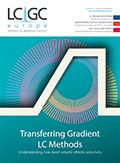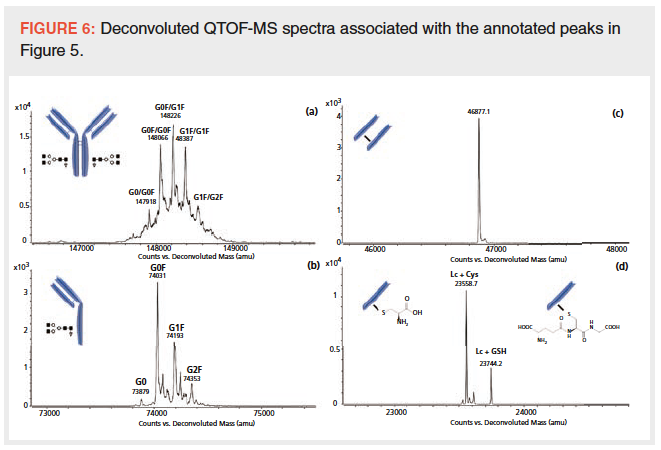Towards Merging Targeted and Untargeted Analysis of the Lipidome, Metabolome, and Exposome
Tomas Cajka previews his keynote lecture at HPLC 2019, where he will introduce an LC−MS workflow (LIpids, Metabolites and eXposome compounds [LIMeX]) for simultaneous extraction of complex lipids, polar metabolites, and exposome compounds that combines LC–MS targeted and untargeted analysis.
Many scientists draw a strict line between targeted and untargeted metabolomics and lipidomics analysis. Untargeted methods focus on the analysis of all the detectable metabolites in a sample, including chemical unknowns, and results are typically reported in arbitrary units (1). Conversely, targeted analysis is the measurement of defined groups of metabolites that are quantified using certified standards (2). However, during untargeted analysis of biological samples, many known metabolites are expected to be detected.
Some of them, such as trimethylamine N-oxide (3), trimethyllysine (4), diacetylspermine (5), branched-chain amino acids (6), acylcarnitines (7), or various lipid species (8), have been reported as biomarkers of various diseases. Merging untargeted analysis with a targeted approach promises to provide not only the data for hypothesisâgenerating studies, but also quantitative data for hypothesis-driven validation. Why is this important? First, reporting absolute concentrations of particular metabolites is crucial to enable direct comparisons of the results between different laboratories and studies. Second, absolute metabolite quantities immediately distinguish major from minor species, allowing biological interpretations of the results in the context of other analytes (9,10).
The true breadth and scope of polar metabolites (metabolome), complex lipids (lipidome), and various exogenous compounds, such as drugs or food components (exposome), cannot be captured by a single extraction method or instrumental platform. Human biospecimens, such as blood, can contain metabolites and exposome compounds covering over 40 orders of magnitude on the octanol–water partition coefficient scale and ranging from femtomole to millimole concentrations (11,12). Historically, metabolomics and lipidomics sample preparation protocols were used separately. Recent research has shown that a single extraction method can be used to isolate both polar metabolites and complex lipids, followed by fractionation and analysis of each fraction under different separation conditions. This is important because some samples are available in very low quantities permitting a single shot. Also, use of separate extraction method for each platform would be laborious and time-consuming (for example, tissue samples). Currently, the use of a liquid–liquid extraction approach using methanol–methyl tert-butyl ether–water (13) or methanol–chloroform–water (14) provides two phases: one containing mostly nonpolar metabolites (complex lipids) and the other mostly consisting of polar metabolites (11). By using appropriate resuspension solvent or solvent mixture, and an appropriate separation and mass spectrometry (MS) configuration, a broad coverage of low-molecular-weight compounds can be obtained by using a single extraction for a given matrix (15).
Sample preparation is one side of the coin. The other one represents sample separation. Coupling separation techniques and MS provides advantages such as separation and detection of isobars and isomers, reduced ion-suppression effects, and the possibility to separate compounds according to their physicochemical properties (11). The main task though is to achieve high metabolite coverage using as few platforms as possible while maintaining the requisite precision and accuracy for the metabolite classes detected by the chosen platforms.
Liquid chromatography (LC)−MS has become the most applied chromatography−MS tool for the analysis of both polar and nonpolar metabolites (~66% applications) followed by gas chromatography−mass spectrometry (GC−MS) used for analysis of volatile metabolites and for primary metabolites after derivatization (~30% applications) and capillary electrophoresis−mass spectrometry (CE−MS) for analysis of polar, charged metabolites (~4% applications) (16,17). Luckily, various LC−MS modes including different stationary phase chemistries and composition of mobile-phase solvents and modifiers are available for separation of small molecules. In metabolomics, reversedâphase LC followed by hydrophilic interaction liquid chromatography (HILIC) are the most frequently used LC-based separation methods (11). In lipidomics, normalâphase LC and supercritical fluid chromatography (SFC) are also used (18).
On top of that, processing of metabolomics and lipidomics data is still challenging in spite of the recent developments in this area. The past processing pipelines were mainly developed for filtering, feature detection, and peak alignment, and the final reports comprise extracted massâtoâcharge (m/z) values, their retention times, and corresponding intensity for all detected peaks (19,20). The current trend is to link these outcomes with automated compound annotation using tandem mass spectral library search (21) if MS/MS spectra were collected either through traditional dataâdependent or novel dataâindependent analysis (DDA, DIA) (22–24). Such an approach allows hundreds of polar metabolites, complex lipids, or exposome compounds to be reported in addition to thousands of unknowns. When comparing different software programs, researchers have focused too much on hunting and reporting as many peaks (features) as possible to ultimately present “the best software”. It is frequently ignored that many features may originate from extraction blank or as mobile-phase impurities, and that the same metabolite can occur as in-source fragments, isotopes, or multiple adducts. Also, without properly tuned and validated parameters it is difficult to draw a conclusion about the comparison of data processing software programs.
In my keynote lecture at HPLC 2019, I will address these challenges and introduce an LC−MS workflow (LIpids, Metabolites and eXposome compounds [LIMeX]) for simultaneous extraction of complex lipids, polar metabolites, and exposome compounds that combines LC–MS targeted and untargeted analysis. Our aim was to look at each step of the metabolomics and lipidomics workflow and streamline where possible to, ultimately, develop a simple, fast, and robust protocol that can be applied for diverse sample types.
References
- N. Vinayavekhin and A. Saghatelian, Curr. Protoc. Mol. Biol.90, 30.1.1–24 (2010).
- L.D. Roberts, A.L. Souza, R.E. Gerszten, et al., Curr. Protoc. Mol. Biol.98, 30.2.1–30.2.24 (2012).
- Z. Wang, E. Klipfell, B.J. Bennett, et al., Nature472, 57–63 (2011).
- X.M.S. Li, Z.N. Wang, T. Cajka, et al., Jci Insight3, e99096 (2018).
- W.R. Wikoff, S. Hanash, B. DeFelice, et al., J. Clin. Oncol.33, 3880–3886 (2015).
- J.R. Mayers, C. Wu, C.B. Clish, et al., Nat. Med. 20, 1193–1198 (2014).
- S.J. Mihalik, B.H. Goodpaster, D.E. Kelley, et al., Obesity18, 1695–1700 (2010).
- X.L. Han, S. Rozen, S.H. Boyle, et al., Plos One6, e21643 (2011).
- K. Simons, Proteomics18, e1800039 (2018).
- T. Cajka, J.T. Smilowitz, and O. Fiehn, Anal. Chem.89, 12360–12368 (2017).
- T. Cajka and O. Fiehn, Anal. Chem. 88, 524–545 (2016).
- C.S. Bloszies and O. Fiehn, Curr. Opin. Toxicol.8, 87–92 (2018).
- V. Matyash, G. Liebisch, T.V. Kurzchalia, et al., J. Lipid Res.49, 1137–1146 (2008).
- J. Folch, M. Lees, and G.H.S. Stanley, J. Biol. Chem.226, 497–509 (1957).
- M.R. Showalter, E.B. Nonnecke, A.L. Linderholm, et al., Plos One13, e0190632 (2018).
- J.L. Wolfender, G. Marti, A. Thomas, et al., J. Chromatogr. A1382, 136–164 (2015).
- G.A. Theodoridis, H.G. Gika, E.J. Want, et al., Anal. Chim. Acta 711, 7–16 (2012).
- T. Cajka and O. Fiehn, TrAC-Trend Anal. Chem. 61, 192–206 (2014).
- R. Tautenhahn, G.J. Patti, D. Rinehart, et al., Anal. Chem.84, 5035–5039 (2012).
- M. Katajamaa, J. Miettinen, and M. Oresic, Bioinformatics22, 634–636 (2006).
- T. Kind, H. Tsugawa, T. Cajka, et al., Mass Spectrom. Rev. 37, 513–532 (2018).
- H.P. Benton, D.M. Wong, S.A. Trauger, et al., Anal. Chem.80, 6382–6389 (2008).
- H. Tsugawa, T. Cajka, T. Kind, et al., Nat. Methods 12, 523–526 (2015).
- T. Pluskal, S. Castillo, A. Villar-Briones, et al., Bmc Bioinformatics11, 395 (2010).

Tomas Cajka received his Ph.D. in 2009 from the University of Chemistry and Technology, Prague, Czech Republic. In 2010 he became an associate professor at the same university. Between 2012 and 2017 he was a specialist and novel technologies leader at the West Coast Metabolomics Center (Metabolomics Fiehn Lab) at University of California, Davis, USA. Currently, he oversees the Department of Metabolomics (core lab) and the Department of Translational Metabolism (research lab) at the Institute of Physiology of the Czech Academy of Sciences. His current research activities include developing novel strategies using cutting-edge LC–MS technologies to merge untargeted and targeted metabolomics and lipidomics methods, expanding the coverage of spectral libraries and identification of unknowns by using in-silico fragmentation software and applying these tools in biomedical research to ultimately improve human health.

Regulatory Deadlines and Supply Chain Challenges Take Center Stage in Nitrosamine Discussion
April 10th 2025During an LCGC International peer exchange, Aloka Srinivasan, Mayank Bhanti, and Amber Burch discussed the regulatory deadlines and supply chain challenges that come with nitrosamine analysis.
















